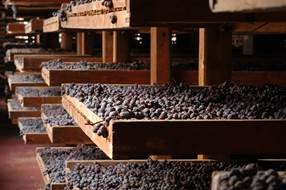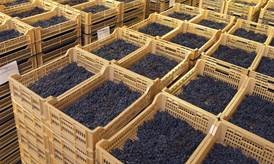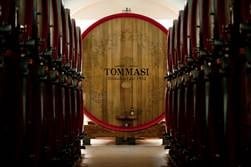Search
Menu

What is this delectable drink we call Amarone? And how is it made?
 Amarone is a dried-grape wine made using the appassimento (ah-pah-see-men-toh) method—a process whereby grapes are left to dry for several months and then pressed once they have lost between 40% and 50% of their original weight.
Amarone is a dried-grape wine made using the appassimento (ah-pah-see-men-toh) method—a process whereby grapes are left to dry for several months and then pressed once they have lost between 40% and 50% of their original weight.
Grapes are picked while they still have slightly higher acidity compared to the grapes destined for regular Valpolicella. Bunches are carefully selected, ideally taking those that are loosely packed so that air can circulate freely around them during the drying period.
 A very unique and complex transformation takes place within the berries and provides the basis of a highly concentrated grape juice for fermentation. It is this transformation that is responsible for Amarone’s complexity of flavor, impressive structure, and noteworthy age¬ability.
A very unique and complex transformation takes place within the berries and provides the basis of a highly concentrated grape juice for fermentation. It is this transformation that is responsible for Amarone’s complexity of flavor, impressive structure, and noteworthy age¬ability.
Grape varieties, drying times and specifications, and aging periods are all regulated by the disciplinare (dee-shee-plee-nahr-ay), a document that regulates production in a given Italian wine region.
 Corvina and Corvinone typically make up a majority of the blend—anywhere from 45% to 95%, with Corvinone accounting for no more than half that amount. Rondinella adds another 5–30% to the blend. Other varieties—including Croatina, Oseleta, Molinara, and international varieties such as Cabernet Sauvignon and Merlot, to name a few—can be used in small doses like one would consult a spice rack.
Corvina and Corvinone typically make up a majority of the blend—anywhere from 45% to 95%, with Corvinone accounting for no more than half that amount. Rondinella adds another 5–30% to the blend. Other varieties—including Croatina, Oseleta, Molinara, and international varieties such as Cabernet Sauvignon and Merlot, to name a few—can be used in small doses like one would consult a spice rack.
The drying period typically lasts between 100 and 120 days, and top producers often dry their grapes for longer periods. The drying process itself differs based on producers’ philosophies and stylistic bents. Drying rooms can range from the simple top floor (or loft) of a winery, outfitted with traditional bamboo or wooden boxes, to modern temperature-controlled facilities. In no case, however, can a producer augment the conditions in a drying room beyond what is naturally occurring in the environment for that given harvest. The use of heat to dry grapes is strictly prohibited.
Unlike most dried-grape wines, Amarone is fermented dry, making for a high alcohol level. It is then aged for a minimum of two years or, in the case of riserva, four years. Again, top producers often exceed these minimums, sometimes by several years.

 Oak-aging regimes also vary among producers. Some prefer large Slavonian oak casks, citing their more gentle nature on the fruit (compared to French barriques) and their ability to promote slow oxygenation that ultimately allows for longer life of the wine in bottle. Those who use French oak barrels do so only for fruit from sites that can stand up to its prominent oak aromas and flavors and more powerful tannins.
Oak-aging regimes also vary among producers. Some prefer large Slavonian oak casks, citing their more gentle nature on the fruit (compared to French barriques) and their ability to promote slow oxygenation that ultimately allows for longer life of the wine in bottle. Those who use French oak barrels do so only for fruit from sites that can stand up to its prominent oak aromas and flavors and more powerful tannins.
The last question involves botrytis. This “noble rot” can introduce a new set of flavors to the wine, so it is strictly a producer decision to encourage it or not, based on stylistic goals for their wine.■
This information makes clear that apassimento is the method of drying grapes, and passito is the resulting wine, that could be dry or sweet.
Thank you.
Thanks for reading Carmen.
Thank you for conveying so much information in such a short article. Writing in such a way is its own skill.
Thanks John, Amarone production is one of my favorite topics and I am fascinated by dried grape wines and their complexity. The process is so interesting. Glad you enjoyed reading it.
Hi - I really enjoy this website and the education and insights it provides. I was recently reading Matt Kramer's book "Making Sense of Italian Wine" about Recioto della Valpolicella (dolce and amaro). He said that the word 'recioto' is dialect for ears or shoulders and refers to the best upper and outer parts of a cluster. He then said that the wine was produced using the "recioto process". From the description, I am gathering that it is the actually the appassimento process and produces the same result as "passito". Apparently, there are several wines produced throughout Italy usiing that drying process. Can you please clarify or straighten me out on that? Thanks!
Brad
Hello Brad, thanks for writing in.
Appassimento is the overall term for the process of drying grapes off the vine in Italy, and Amarone and Recioto are unquestionably appassimento wines, so you are correct. The term passito is often used to refer to the style of wine made using the appassimento process.
Recioto was traditionally made from the ripest grapes on bunches—those most exposed—thus the reference to the figurative “ears” or “shoulders” of the bunch. To this day, Recioto is only made in the best years, when those ripest bunches/sections can be achieved. The Italian word for ear is orecchio, and presumably the dialectic derivation recioto comes from that word. (You may also be familiar with orechiette pasta popular in southern Italy, which translates as “little ears” due to its concave rounded shape.)
Lastly, yes, there are actually quite a few passito-style wines made in Italy using some variation of the drying process—some hung in rooms, some laid out on mats, some laid out on the ground outside, etc.
France, Austria, Germany, Spain, Greece, and many other countries have their own styles of passito wine, as well. The “Recioto process” is not necessarily a unique version of appassimento but just how growers in the area go about making these wines (and remember, there are also reciotos made with Garganega in Soave and Gambellara).